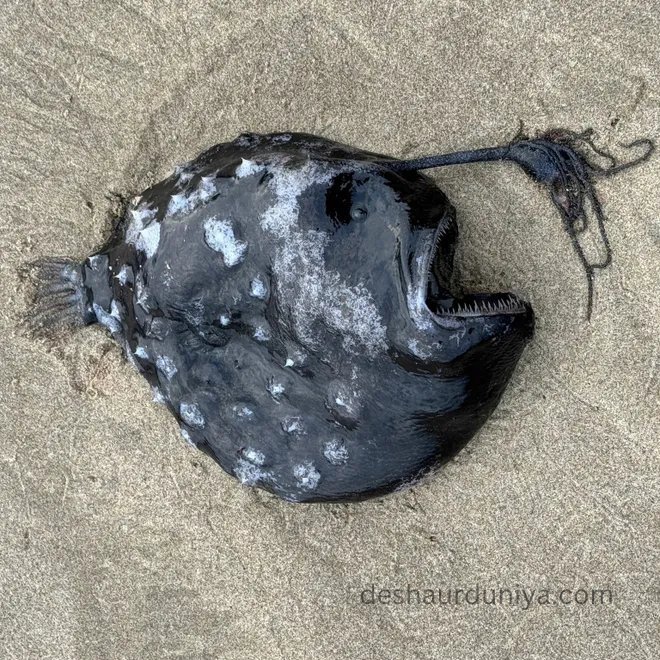Shocking First: Nightmarish Footballfish Washes Up Dead on US Beach
The shocking first occurrence of a nightmarish footballfish washing up dead on a US beach has left beachgoers and marine biologists in awe. This rare and eerie deep-sea creature, usually found in the dark depths of the ocean, has been discovered lifeless on the shores, sparking curiosity and concern.

Nightmarish 'footballfish' washes up dead on US beach in potential 1st-of-its-kind occurrence
A female Pacific footballfish was found dead on an Oregon beach — possibly for the first time ever. It's not clear what killed the strange-looking creature or how it was pulled up from the depths.
A black anglerfish lying on a beach
A female Pacific footballfish was recently found dead on a beach in Oregon. (Image credit: Seaside Aquarium)
An extremely rare, deep-sea "footballfish" recently washed up dead on a beach in Oregon — possibly for the first time in the state's history. It's unclear what killed the eerie-looking creature or how it ended up there.
The nightmarish Pacific footballfish (Himantolophus sagamius) is a type of anglerfish (Lophiiformes) — a group of more than 300 deep-sea fish species that hide in the dark and attract prey with glowing headpieces. Footballfish can live in waters as deep as 3,300 feet (1,000 meters) below the surface and likely inhabit the Pacific Ocean's depths, though their exact range is unknown.
Beachcombers found the dead, alien-looking fish on the shore south of Cannon Beach earlier this month, according to a May 19 Facebook post from the Seaside Aquarium. It's unclear whether researchers collected and studied the remains after aquarium staff took photos, which could help explain the creature's mysterious fate.
Pacific footballfish are extremely rare. Since the first one was accidentally collected in 1975 during a deep-sea trawl in Hawaii, only about 30 individuals have ever been found washed ashore or in the wild, according to the Natural History Museum of Los Angeles County.
"While a few football fish have been recorded in New Zealand, Japan, Russia, Hawaii, Ecuador, Chile, and California, this is the first one reported on the Oregon Coast to our knowledge," Seaside Aquarium representatives wrote.
Before this recent case, the most recent Pacific footballfish found in the U.S. was a female discovered on a beach in Crystal Cove State Park, California, in October 2023. Interestingly, another female was found on the same beach in May 2021, although scientists don't know why both specimens washed up in the same place.
Related: 10 creatures that washed up on the world's beaches in 2023
A close-up of the fish's lure and teeth
There is currently no explanation for why the footballfish washed up dead. (Image credit: Seaside Aquarium)
Like most other anglerfish, footballfish lures are modified parts of the fish's dorsal fin and house glowing bacteria that produce light in exchange for protection and nutrients. But unlike most other anglerfish, which have a single bulb-like lure, Pacific footballfish have segmented lures with multiple tendrils extending from the end of their head stalks.
Previous research showed that footballfish lures are biofluorescent, meaning they can absorb and reflect light, as well as produce it. This has not been observed in other anglerfish species so far, and researchers think it may enable the footballfish to produce more complex and enticing light displays than other anglerfish.
Footballfish use their lures to draw prey toward their mouths, close enough for the hidden predators to suck them into their gullets in one quick move. Rows of spiky teeth line the mouths of these predators and point inward to trap the startled prey, according to the California Academy of Sciences.
Like other anglerfish, female Pacific footballfish are much bigger than the males — a phenomenon known as sexual dimorphism. The females, like the one that washed up in Oregon, can grow to about 2 feet (0.6 meters) long, while males only reach about 10% of this size.
RELATED CONTENT
—Super-rare dreamer anglerfish with ultra-black 'invisibility cloak' swims like a shadow in the deep sea
—Upside-down anglerfish and other alien oddities spotted in one of the world's deepest trenches
—New footage shows bizarre deep-sea fish that sees through its forehead
This stark size difference is due to an evolutionary oddity known as sexual parasitism. The males act like parasites and spend their whole lives looking for a female host, then attach to the first one they find — and stay there forever. The males eventually fuse completely to the females and become mini sperm factories that fertilize her eggs.
"How the males find the females in the pitch dark is still unknown," Seaside Aquarium representatives wrote. But it was likely a key factor in anglerfish evolving to thrive in the deep sea.
What's Your Reaction?






















